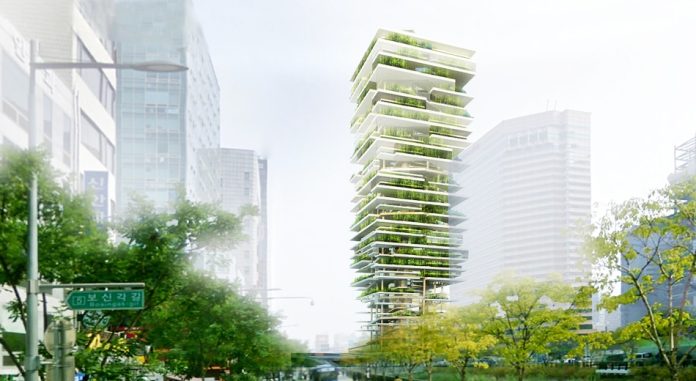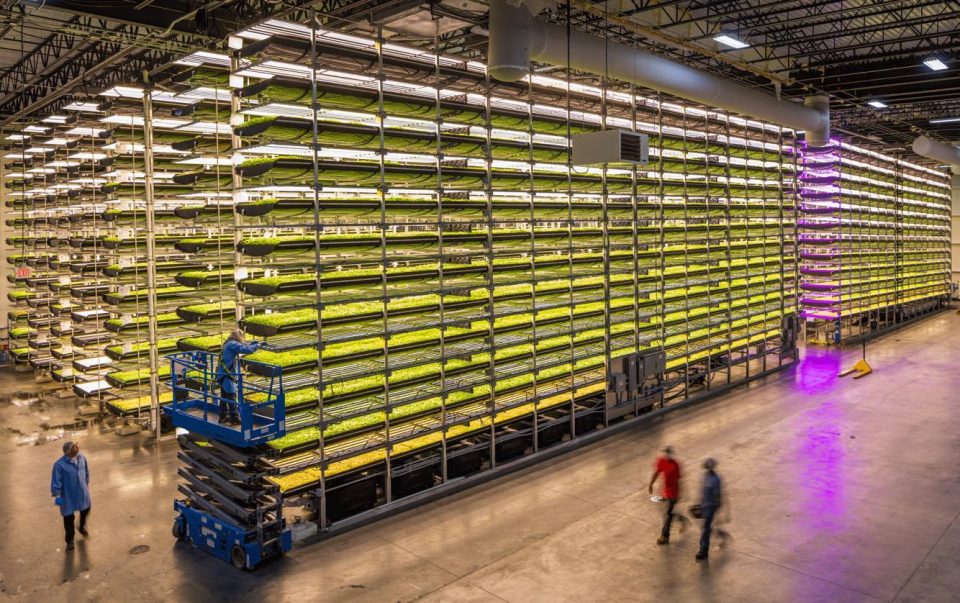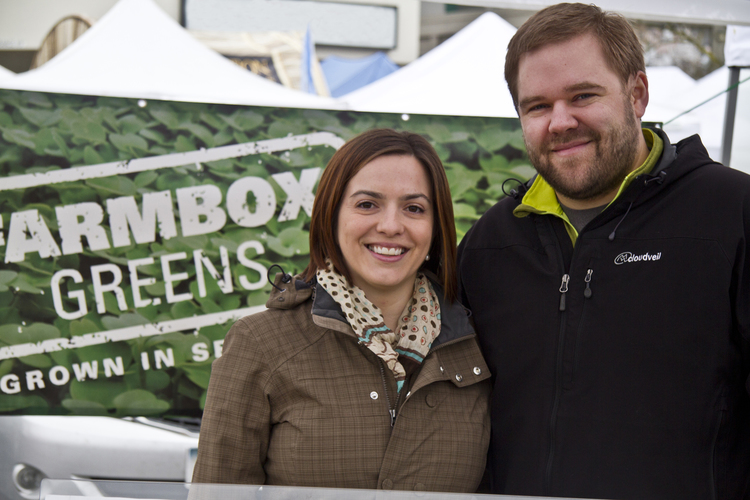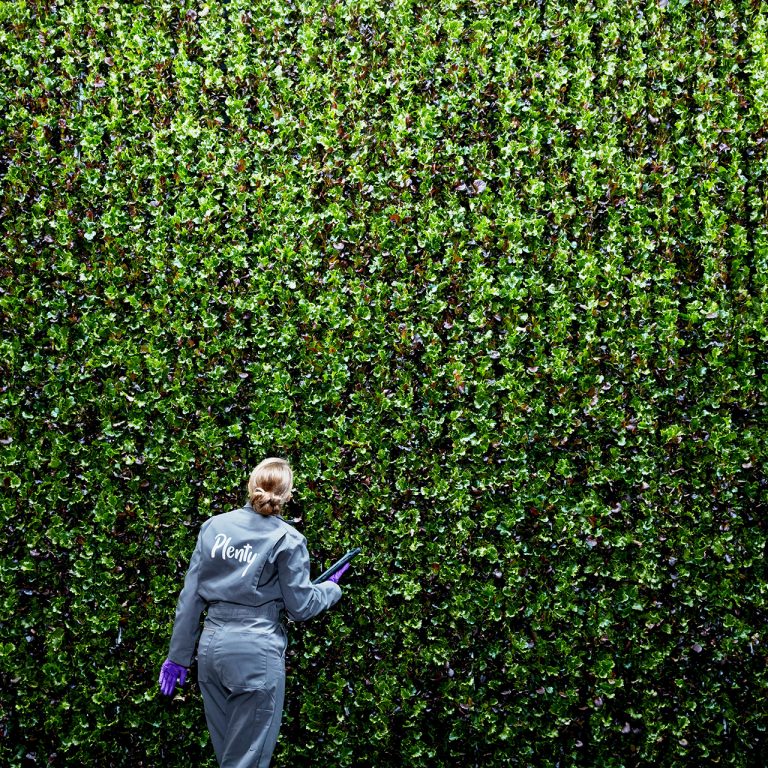
Today, common agricultural practices come with significant environmental costs. The sector depletes fresh water supplies, occupies large swathes of land, and emits major greenhouse gas (GHG) emissions from the production of crops and the transportation of that produce. As everyday people strive to reduce their environmental impacts, the agricultural industry becomes a major target for environmentalists.
One solution that technically-minded environmentalists tout is vertical farming. With the exception of the upfront environmental costs, vertical farming is advantaged in virtually all other environmental indicators. The technology reduces carbon, water, pollution, and sustainability costs of conventional agriculture. Its potential yields and business model has also attracted the capital and expertise of big tech.
Vertical farming lies at the intersection of agriculture and cutting-edge technology. The method consists of planting in a vertically-built environment, but anyone could build a relatively cheap farm vertically. The technical side of vertical farming comes into play when controlled-environment agriculture (CEA) becomes integrated into the vertical structure.
A CEA facility can control temperature, humidity, carbon dioxide, light, nutrient concentration, and acidity. These CEA facilities can be housed by a greenhouse or building that shields the farm from the outside world, removing pests and seasonal weather patterns. Likewise, the outside world can be protected from the agriculture practiced inside a CEA facility, removing runoff risk. CEA also implements technologies such as hydroponics, aquaponics, and/or aeroponics.
Hydroponics is a method of growing plants with nutrient solutions in a soilless medium. Aquaponics goes a bit further and combines hydroponics with aquaculture, or fish farming. Waste from marine life gets converted to nitrate by bacteria, the nitrate is absorbed by the plants, which cleans the water for the fish. Outside of just the air, aeroponics uses no growth medium and uses nutrient-rich mist to grow plants.
Not all vertical farms can deploy a fully equipped facility, but a partially equipped one will still provide economic and environmental advantages over conventional farms. Densely built farms paired with existing agricultural technologies allow scientists and entrepreneurs to innovate methods of producing food in a more efficient, productive, and environmentally friendly manner.
The economics
Significant capital has been attracted by the efficiencies produced by vertical farms. These efficiencies come from the removal of factors that cause yield loss and an ability to yield more than the average farms.
In a CEA vertical farm lighting, water, temperature, and any other relevant variables can all be optimized to enhance production rates. Arrays of LEDs are utilized to bathe plants in adjustable, uninterrupted, and ideal light. LED lights are also used to influence the wavelengths of light that crops receive, which can increase growth rates and nutrition values. Some vertical farms use aeroponic systems to provide the right amount of water and nutrients, with temperature and humidity constantly fine-tuned. Altogether, vertical farms can manipulate conditions so that each crop is granted perfect growing conditions.
The controlled environment also insulates vegetation from seasonal and extreme weather patterns that can devastate traditional and industrial farming operations. This protection is becoming increasingly important as changing climate is affecting weather patterns that established farms experience. The use of a controlled environment also eliminates and protects from pest and blight related losses that must be factored in on conventional farms, cutting the need for pesticides.
As a result, David Rosenberg, founder of AeroFarms, has claimed that yields in his New York vertical farms were 130 times greater per acre than conventional farms. There are claims that vertical farming can have yields 390 or ever 530 times greater than horizontal farms. These numbers will likely vary depending on how tall and technically advanced a vertical farm is built. The vertical component of these farms allows agriculture to scale to the limits of a plot’s building restrictions.

Actual yield differences between vertical farms and traditional/industrial farms will depend on the technology and height utilized by a vertical farmer. There are also yields differences by crop; leaf vegetables have probably seen the most innovation within vertical farms due to their high margins, short production cycles, and high harvestable yields. Theoretically, all crops could be produced in vertical farms, but limiting factors like long production cycles and low harvestable yields have currently kept tree fruits and root vegetables out of vertical farms.
Vertical farms also provide marketers with a high-quality commodity to advertise. The lack of pesticides and chemicals involved in cultivation, allow some vertical farms to claim the organic label. Transportation costs are low because vertical farms are often located within or next to density populated regions. That proximity allows vertical farms to mitigate much of the quick nutrition loss experienced by fresh produce within a day or days of harvest. Seasonal produce can be produced year-round in a vertical farm, which allows entrepreneurs to exploit opportunities in local agricultural markets. Short-term changes in consumer demand can also be adapted to with the agility and productivity of a vertical farm’s organization.
Given the potential yields and profitability of vertical farms, why aren’t they everywhere? Well, there are immense upfront capital barriers for vertical farm construction. It isn’t uncommon for an advanced facility to cost upwards of tens of millions of dollars. Energy usage is also a considerable cost, as a facility’s vast array of lighting, climate control apparatus, and agricultural systems require uninterrupted power. These significant upfront costs and power costs come with externalities, many of which are environmental.
The environment
Associated with any considerable capital project are upfront environmental costs. Sourcing, processing, manufacturing, and shipping of the components needed to construct vertical farms all have their various negative environmental externalities. GHG emissions, pollution, freshwater consumption, and waste generation are currently all unavoidable costs to development.
Added to those upfront environmental costs for vertical farming is sustained energy and material consumption concerns for the maintenance and operation of a controlled environment and agricultural systems. Material inputs to operate a hydroponic or aeroponic system have their attached environmental costs. Depending on the energy sources that a vertical farm relies upon, the sustained GHG emissions become a major concern. A coal-powered vertical farm would be incredibly costly and dirty. Likewise, if renewable energy sources power a vertical farm, then those emissions concerns dissipate.
Both upfront and continued environmental concerns are shared by electric vehicles, renewable energy, transportation, density, and other green infrastructure projects. Each has the aim of solving the environmental concerns of their associated sectors, but comes with initial environmental costs. In vertical farming’s case, it aims to reduce the impact of conventional agriculture.
Freshwater savings are the easiest and the most considerable benefit of vertical farming. The Earth’s freshwater supply is being drained faster than it is being replenished. Much of the world’s demand for freshwater is driven by agriculture, which accounts for 70% of global freshwater use. Additionally, food production will need to grow by 69% by 2035 to feed the world’s growing population, putting further strain on freshwater supplies.
CEA vertical farms use 95% less water than conventional farms. Some operations, like FreshBox farms, claim upwards of 99% less water usage. CEA vertical farming requires far less water than outdoor farming because there is recycling of greywater, and minimized evaporation and excess. The lack of soil in hydroponic vertical farm operations also prevents wasteful absorption by in-ground soil systems.

Using soilless growth mediums allows vertical farmers to avoid emissions of nitrous oxide (N2O) resulting from various management practices on agricultural soils. The emission of N2O, a potent GHG, results from the application of nitrogen fertilizers, such as mineral N or organic fertilizers. Agricultural soils are also a minor source of methane. According to the United States Environmental Protection Agency, management of soils accounts for nearly half of the emissions from the agriculture economic sector.
Absence of outdoor soil operation removes the consequences of nonpoint source (NPS) pollution in a CEA vertical farm operation. NPS pollution comes from diffuse sources, in the case of conventional agriculture, runoff is the main offender. On conventional farms, runoff transports sediment, nutrients, and pesticides into nearby bodies of water. There, sediment and soil clouds water, and harms wildlife; nutrients creates algae blooms, fouls drinking water, and kills wildlife; pesticides poison wildlife, contaminate food sources, and destroys habitat. On a CEA operation, any runoff potential can be contained, processed, recycled, and properly disposed of.
Depending on the location of a vertical farm and its consumers, the carbon cost of agriculture’s “food-miles” can be drastically reduced. “Food-miles” is a measure of how far food travels between its production and final consumers, and moreover the carbon cost of that transportation. A study done by researchers at Carnegie Mellon University found that transportation represents 11% of agriculture’s GHG emissions.
Vertical farms tend to be in or around urban areas, whose population becomes the primary consumer of vertically farmed produce. This proximity/localization produces transportation GHG emissions much less than that of agricultural produce from rural areas, whose consumers tend to be much farther away.
The difference in GHG emissions can be drastically increased if a vertical farm is producing a crop that typically or seasonally must be imported from abroad. For example, 52.7% of tomatoes consumed in the United States were grown abroad. Today, vertical farms can and do grow tomatoes next to population centers. Many berry varieties are also imported and can also be grown hydroponically in a vertical farm. Especially with projections of increased produce imports, vertical farms offer a reduction to an average consumer’s food-miles.
Conventional agriculture also incurs a land use opportunity cost that vertical farms barely pay. Without a technology improvement, conventional agriculture must increase its land use footprint to increase production. The land used for conventional agriculture could instead be used for carbon sequestration and storage, conservation, and any other ecological restoration or GHG neutral or negative use.
Vertical farms occupy minimal land and can be scaled vertically to increase production, offering a more sustainable way of increasing food production. Their contained nature also shelters the surrounding areas from any potential agricultural contamination.
Vertical farms in society today
Vertical farming’s minimal footprint has attracted attention from arable land-constrained countries. Especially, nation states in the Asia-Pacific region have invested in the construction of vertical farming infrastructure and development of related technology. The Asia-Pacific region generated the highest revenue of $835 million for agricultural technologies used in vertical farms in 2017 and is expected to lead the rest of the world in vertical farm expenditure.
The region is strongly motivated by lack of fertile land and growing demand for fresh produce. This has prompted the region’s strong technical expertise in agricultural practices, and established research and development institutes in China and Japan to further supplement the development and growth of vertical farming. The United States Department of Agriculture and other governments internationally are also funding and researching vertical agriculture. Some of the nation states also subsidize vertical farms to support rough start-up phases experienced by the adolescent industry.
Singapore is one of those nation states and arguably benefits the most from this technical development. The city state only has 278.6 square miles of land to work with, giving it little allowance for conventional farming. Singapore has to import around 90% of its food, but hydroponics and vertical farms have increased the state’s domestic vegetable production. Vertical farms can boost Singapore’s food security that it cannot afford to provide itself with conventional farming.
Within the Pacific Northwest region, Seattle and its greater area play host to a few vertical farms. Under Seattle zoning law, vertical farms likely fall under the urban farm definitions. Urban farms can be built in residential, commercial, and industrial zones. In residential zones, Seattle urban farms require an administrative conditional use permit for over 4,000 square feet of planting area. In commercial and industrial zones, urban farms have no size of use restrictions outside of building restrictions of the corresponding zone ordinances.
SODO is home to Farmbox Greens, Seattle’s first vertical farming operation. Farmbox uses Vertical Farming techniques and hydroponics to grow microgreens. They control their farm’s environment by monitoring and adjusting air temperature, CO2, humidity, and air circulation. The company claims 90% less water usage compared to conventional farms. Today, Farmbox only grows high margin microgreens, which are sold at local markets and restaurants.

Just outside of Seattle, Jeff Bezos-backed Plenty farms began operation of its 100,000-square-foot Kent facility in 2018. This certified-organic farm grows produce with hydroponic technology in a CEA facility. Plenty claims that its technology can achieve yields of up to 350 times greater than conventional horticulture with only 1% of the water and hardly any land. Plenty’s farms can grow up to 300 variants of produce, of which its Kent facility can produce 4.5 million pounds annually. Spring mix and kale among first varieties offered from their Kent location.

Just like Bezos’s Amazon, expect vertical farming to displace workers and communities if or when it becomes mainstream. Today, vertical farms mostly grow leafy greens due to their high margins. However, as the technology improves, so will the number of profitable varieties of vertically farmed produce.
When vertical farms start undercutting horizontal farmers, local organic farmers may feel the impacts first due to a shared marketing scheme. Vertical farms will provide some employment for those local farmers, but some of the jobs will require different skill sets. Rural farmers may be at the most risk from economic displacement since only urban areas benefit from vertical farm employment.
The threat of displacement is furthered by automation, which has already reduced the workforce in agriculture. Automation is already being used in Bowery farming, whose New Jersey farm is majority automated. On the farm, data is collected by sensors and a computer controls the growing environment. There are some duties that are more difficult to automate, and still require human labor, but expect that number of tasks to slowly decrease.
Other alternatives to conventional farming
Critics of advanced vertical farming fairly target the technology’s major upfront environment costs and energy usage. There are scenarios where I would agree that are not suitable for vertical farming. Factors such as high fossil fuel energy generation, and low density can make vertical farming incredibly costly and unappealing. Instead of vertical farming, some environmentalists look to regenerative farming for an alternative to conventional farming.
Regenerative farming is a broad system of agriculture that is unified by principles of abandoning tillage, eliminating events of bare soil, diversifying plant varieties on the farm, and integrating livestock and horticultural operations. Practices include no or little tillage, well-managed grazing, cover crops, crop rotation, compost, polyculture, agroforestry, and other practices that integrate the natural ecosystem with agriculture.
The system has claimed little to no pesticide usage, and greater profit for farmers due to marketing, reduced input costs, and diversified income stream. Claims over yield increase or decrease are contested, but there are clear reductions in runoff and increases in carbon sequestration. The Rodale Institute claims that on-farm soil carbon sequestration practiced in regentive agriculture can potentially sequester the equivalent of roughly 52 gigatonnes of carbon dioxide. Reductions in nitrogen fertilizer usage also lead to low nitrous oxide emissions from regenerative farms. While less notable, food miles are not necessarily reduced with the system.
With the exception of the rare aquaponic vertical farm, animal agriculture production is unaffected by vertical farming. Emissions from livestock, water use and emissions from livestock feed are major contributors to agriculture’s food print. Lab-grown and plant-based meat has the potential to reduce the impacts to livestock by substituting it with a product that efficiently processes its inputs for desirable calories. The capital investment attracted by Impossible Foods and Beyond Meat, mirror that of vertical farms and will likely have similar upfront energy and environmental costs and energy usage.
So what now and what’s next
For me, vertical farming slots in an agricultural niche that should be a part of urbanism thought. Vertical farms grant cities the ability to reduce the long-term environmental impacts of their residents. Mixed-use neighborhoods can become more mixed with agriculture integrated into them. Vertical farms can bring a city much needed food security and more employment.
Just like other density focused solutions in urbanism, vertical farms benefit from liberalized zoning regulations. As mentioned earlier, Seattle already allows urban farms to be built in most zoning districts, so easing height restrictions and rezoning would also benefit vertical farming. How vertical farming and dense housing compete for land is up for the market and public to decide.
So far it looks like the peripheries of urban areas are the preferred locations. I would personally like to see infrastructure that combines residential and agriculture to further acquaint the public with their food. Agriculture has historically been where much of suburbia is today. A return in the form of vertical farming would be a welcome transformation of the role of the suburbs.
Technological progress will further increase the appeal of vertical farming. As manufacturing advances and carbon-free energy generation increases, the upfront and long-term environmental costs of vertical farming decrease. Continued advancement in technologies utilized in vertical farms will boost its own economic and environmental benefits.
Vertical farms are on the rise, public and private entities are ensuring that vertical agriculture, and their associated technologies become a noteworthy player in agriculture. I hope that urbanists recognize the potential land use and environmental benefits of the technology. In the meantime, if you already support density and urban growth, keep it up because that’ll benefit the vertical farming industry too.
Editor’s note: The featured top image is courtesy of Zoubeir Azouz Architecture.
Shaun Kuo is a junior editor at The Urbanist and a recent graduate from the UW Tacoma Master of Arts in Community Planning. He is a urban planner at the Puget Sound Regional Council and a Seattle native that has lived in Wallingford, Northgate, and Lake Forest Park. He enjoys exploring the city by bus and foot.


